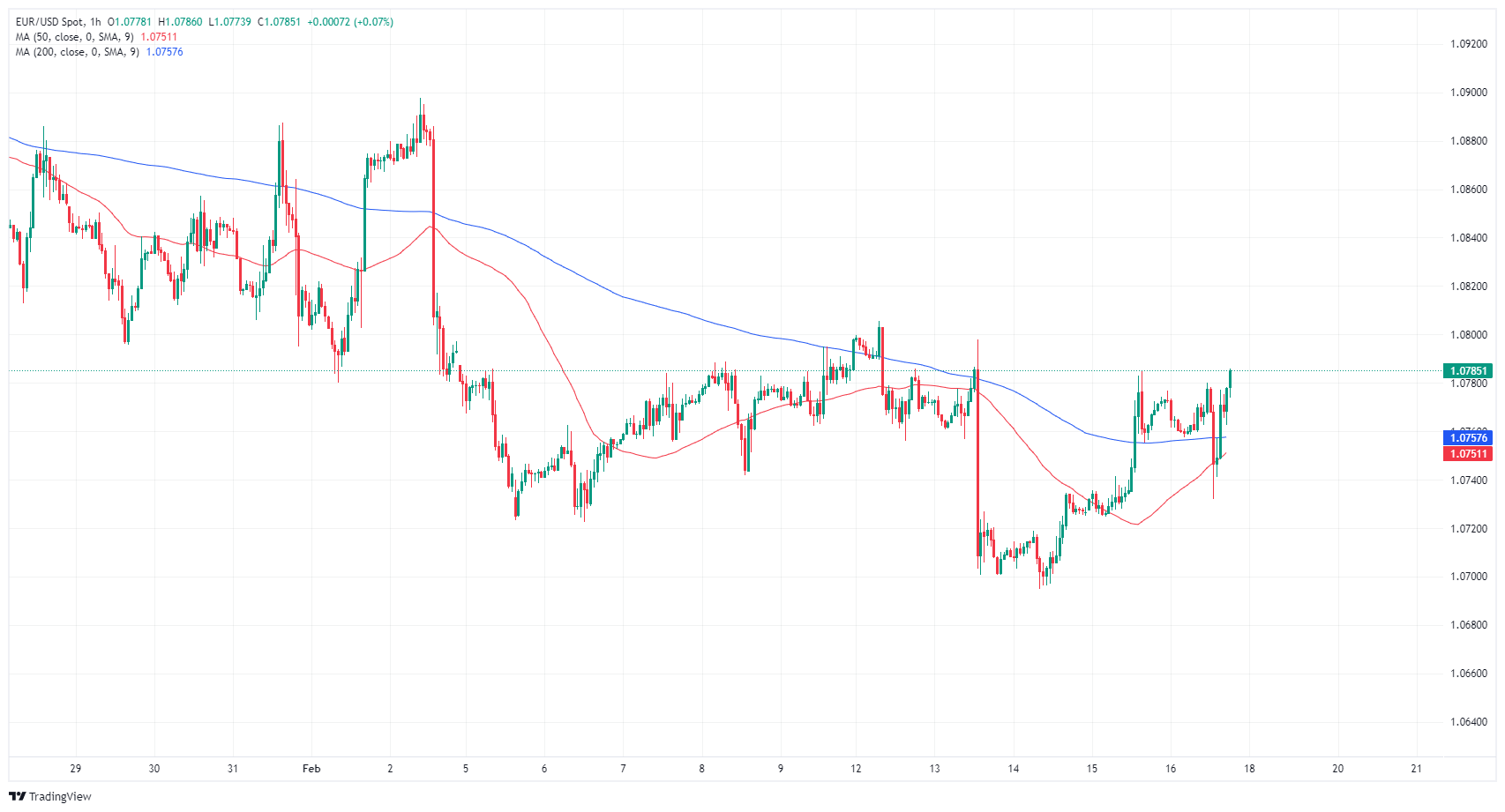- EUR/USD continues to test a short-term top at 1.0780.
- European PMI indices will be published next Thursday, and until then data will be scarce.
- US PPIs rose on Friday, pinning markets in the middle of the range.
The EUR/USD pair is turning in place on Friday after a brief test on the lower side, but lukewarm markets are keeping the pair pinned near the day's opening bids as traders buckle up for the trading bell. closing of the week.
The Euro (EUR) won't have much economic data until next week's Purchasing Managers' Index (PMI), and US data hasn't provided much to talk about after the US Producer Prices (IPP) will rise instead of fall. US markets will be in the dark on Monday for the President's Day holiday, and traders will wait until Wednesday's Federal Reserve (Fed) Minutes for clues about how close (or far) the US central bank is. US to cut interest rates.
Daily Market Summary: EUR/USD Struggles Out of Short-Term Congestion
- The US annualized core PPI rose to 2.0% in January, above the forecast of 1.6% and 1.7% in the previous period (revised from 1.8%).
- On a month-on-month basis, the US PPI rose 0.3% in January, accelerating above the expected rebound to 0.1% from -0.1% in the previous month.
- The Michigan Consumer Sentiment Index rose to 79.6 in February, but below the forecast of 80.0 from 79.0 in January.
- The University of Michigan survey of consumers' 5-year inflation expectations held steady at 2.9% in February.
- Still-elevated inflation expectations and rising producer-level inflation continue to irritate investors eager for rate cuts from the Fed.
- Next week the minutes of the latest meeting of the Federal Open Market Committee (FOMC) will be published.
- As for the euro, the Purchasing Managers' Index (PMI) will be published on Thursday.
- The pan-European HCOB composite index is expected to rise slightly to 48.5 in February, up from 47.9 in January.
- Europe's HCOB Composite PMI has been in contraction territory below 50.0 since July last year.
Current rate of the Canadian dollar
Below is the percentage change of the Canadian Dollar (CAD) against the currencies listed today. The Canadian dollar appreciated against the Japanese yen.
| USD | EUR | GBP | CAD | AUD | JPY | NZD | CHF | |
| USD | -0.12% | -0.17% | 0.08% | -0.25% | 0.13% | -0.37% | -0.01% | |
| EUR | 0.12% | -0.07% | 0.20% | -0.12% | 0.24% | -0.24% | 0.11% | |
| GBP | 0.16% | 0.05% | 0.25% | -0.09% | 0.30% | -0.20% | 0.18% | |
| CAD | -0.09% | -0.20% | -0.25% | -0.33% | 0.05% | -0.46% | -0.09% | |
| AUD | 0.26% | 0.16% | 0.11% | 0.35% | 0.40% | -0.09% | 0.27% | |
| JPY | -0.12% | -0.24% | -0.28% | -0.06% | -0.39% | -0.48% | -0.11% | |
| NZD | 0.36% | 0.26% | 0.20% | 0.45% | 0.12% | 0.50% | 0.38% | |
| CHF | -0.02% | -0.13% | -0.18% | 0.07% | -0.26% | 0.12% | -0.38% |
The heat map shows the percentage changes of the major currencies against each other. The base currency is chosen in the left column, while the quote currency is chosen in the top row. For example, if you choose the euro in the left column and scroll down the horizontal line to the Japanese yen, the percentage change in the box will represent EUR (base)/JPY (quote).
Technical Analysis: EUR/USD struggles to create bullish momentum, 1.0800 remains the level to beat
EUR/USD is stuck around the 200 hourly moving average (SMA) near 1.0760 with the pair struggling to find the bullish momentum needed to reclaim the 1.0800 area. The EUR/USD pair has moved in both directions during the trading session on Friday, and at the time of writing, the pair is barely up a tenth of a percentage point.
The EUR/USD pair is on track to close on the bearish side of the 200-day SMA near 1.0830 for the 10th consecutive day of trading, as the pair is plagued by regular bearish hits, and bidders are struggling to dig their heels in. and avoid further fall. The pair is still down more than 3% from December bid highs near 1.1140.
EUR/USD hourly chart

EUR/USD Daily Chart

Frequently asked questions about the Euro
What is the Euro?
The Euro is the currency of the 20 countries of the European Union that belong to the euro zone. It is the second most traded currency in the world, behind the US dollar. In 2022, it accounted for 31% of all foreign exchange transactions, with an average daily volume of more than $2.2 trillion per day.
EUR/USD is the most traded currency pair in the world, accounting for an estimated 30% of all transactions, followed by EUR/JPY (4%), EUR/GBP (3%) and EUR/AUD (2% ).
What is the ECB and how does it influence the Euro?
The European Central Bank (ECB), headquartered in Frankfurt, Germany, is the reserve bank of the euro zone. The ECB sets interest rates and manages monetary policy
The ECB's main mandate is to maintain price stability, which means controlling inflation or stimulating growth. Its main instrument is to raise or lower interest rates. Relatively high interest rates – or the expectation of higher rates – tend to benefit the Euro and vice versa.
The Governing Council of the ECB takes monetary policy decisions at meetings held eight times a year. Decisions are made by the heads of the eurozone's national banks and six permanent members, including ECB President Christine Lagarde.
How do inflation data influence the value of the Euro?
Eurozone inflation data, measured by the Harmonized Index of Consumer Prices (HICP), are important econometric data for the euro. If inflation rises more than expected, especially if it exceeds the 2% target set by the ECB, it is forced to raise interest rates to bring it back under control.
Relatively high interest rates compared to their peers tend to benefit the Euro, as it makes the region more attractive as a place for global investors to park their money.
How do economic data influence the value of the Euro?
Data releases measure the health of the economy and can influence the Euro. Indicators such as GDP, manufacturing and services PMIs, employment and consumer sentiment surveys can influence the direction of the single currency.
A strong economy is good for the Euro. Not only does it attract more foreign investment, but it may encourage the ECB to raise interest rates, which will directly strengthen the Euro. Conversely, if economic data is weak, the Euro is likely to fall.
The economic data for the four largest economies in the eurozone (Germany, France, Italy and Spain) are especially significant, as they represent 75% of the eurozone economy.
How does the trade balance affect the Euro?
Another important release for the euro is the trade balance. This indicator measures the difference between what a country earns from its exports and what it spends on imports during a given period.
If a country produces highly sought-after export products, its currency will appreciate due to the additional demand created by foreign buyers wishing to purchase these goods. Therefore, a positive net trade balance strengthens a currency and vice versa for a negative balance.
Source: Fx Street
I am Joshua Winder, a senior-level journalist and editor at World Stock Market. I specialize in covering news related to the stock market and economic trends. With more than 8 years of experience in this field, I have become an expert in financial reporting.







